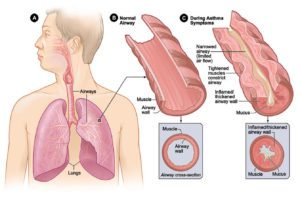

airway. Figure C shows a cross-section of an airway during asthma symptoms.
Springtime brings warmer weather and blooming plants, increasing environmental triggers for people with chronic lung conditions like asthma.
“As pollen counts rise, people with allergies can experience flare ups in asthma and other lung conditions. Springtime is particularly challenging,” said Tammy Baker, A.R.N.P. (Advanced Registered Nurse Practitioner) with Gulf Coast Pulmonology Associates in Venice. She works with a team of pulmonologists caring for patients in the practice and at Venice Regional Bayfront Health.
Pollen is a common trigger for asthma, which is a chronic (long-term) lung disease that inflames and narrows the airways. Asthma causes recurring periods of wheezing (a whistling sound when you breathe), chest tightness, shortness of breath, and coughing. The coughing often occurs at night or early in the morning.
Asthma affects people of all ages, but it most often starts during childhood. According to the National Heart, Lung and Blood Institute of the National Institutes of Health, more than 25 million people in the United States are known to have asthma. About 7 million of these people are children.
“There is really no cure for asthma, so the goal is to control the disease, which will prevent troublesome symptoms, reduce the need for rescue medications, let you maintain a normal activity level and sleep, and help maintain lung function. Preventing asthma attacks could prevent ER visits and hospitalizations, and reduce health care costs,” Baker said.
Understanding Asthma
To understand asthma, it helps to know how the airways work. The airways are tubes that carry air into and out of your lungs. People who have asthma have inflamed airways. The inflammation makes the airways swollen and very sensitive. The airways tend to react strongly to certain inhaled substances.
When the airways react, the muscles around them tighten. This narrows the airways, causing less air to flow into the lungs. The swelling also can worsen, making the airways even narrower. Cells in the airways might make more mucus than usual. Mucus is a sticky, thick liquid that can further narrow the airways.
This chain reaction can result in asthma symptoms. Symptoms can happen each time the airways are inflamed. Sometimes asthma symptoms are mild and go away on their own or after minimal treatment with asthma medicine. Other times, symptoms continue to get worse.
When symptoms get more intense and/or more symptoms occur, you’re having an asthma attack. Treating symptoms when you first notice them is important. This will help prevent the symptoms from worsening and causing a severe asthma attack. Severe asthma attacks may require emergency care, and they can be fatal.
“Having asthma attacks over and over can cause chronic changes in the lungs,” Baker said. “Many asthma sufferers, particularly older people, may eventually end up with chronic obstructive pulmonary disease (COPD).”
Risk factors for asthma are numerous, but Baker said the most common are genetics, allergies, respiratory infections and smoking. Obesity also may contribute.
“We usually see a combination of risk factors in asthma patients,” she said.
Asthma is initially diagnosed by symptoms. To confirm the diagnosis, pulmonologists use tests that assess how well air is moving from the lungs, as well as a blood test to look for high levels of eosinophil, a white blood cell. In asthma sufferers, the body’s immune system goes into “over-drive,” producing too many eosinophil cells.
Living with Asthma
Once asthma is diagnosed, the pulmonologist works with the patient to develop a plan to manage the condition. The plan is likely to include avoiding triggers, medication, and making healthy lifestyle choices, including exercise. Medication can include a long-acting, inhaled corticosteroid to prevent symptoms, combined with a short-acting rescue inhaler in case of an attack. Oral medications and injections are additional options.
According to Baker, asthma is well-controlled if your symptoms require a rescue inhaler no more than two days a week; you can do normal activities without difficulty; symptoms don’t wake you more than twice a month; you have no more than one asthma attack per year that requires oral corticosteroids; and your peak flow (a measure of lung function) is at least 80 percent of your personal best.
“Asthma is more than uncomfortable – an attack can be fatal. However, working with your doctor to manage the condition can allow you to live a normal, full life,” Baker said.
For more information about asthma, call 941-488-1906 or visit GulfCoastMedicalGroup.net
Information from the American Lung Association (lung.org) and the National Heart, Lung and Blood Institute; National Institutes of Health; U.S. Department of Health and Human Services (nhlbi.nih.gov) was used in this report.
 Southwest Florida's Health and Wellness Magazine Health and Wellness Articles
Southwest Florida's Health and Wellness Magazine Health and Wellness Articles

